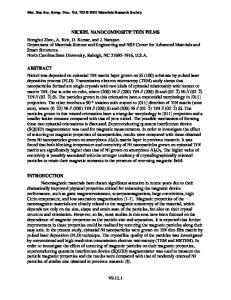Phase Transition Behaviors of AgInSbTe-SiO2 Nanocomposite Thin Films for Phase-change Memory Applications
- PDF / 466,486 Bytes
- 6 Pages / 612 x 792 pts (letter) Page_size
- 19 Downloads / 319 Views
1251-H03-04
Phase Transition Behaviors of AgInSbTe-SiO2 Nanocomposite Thin Films for Phasechange Memory Applications Yu-Jen Huang, Tzu-Chin Chung, Chiung-Hsin Wang, Tsung-Eong Hsieh Department of Materials Science and Engineering, National Chiao Tung University 1001 Ta-Hsueh Road, Hsinchu, Taiwan 30010, R.O.C. ABSTRACT Phase-change kinetics, structure evolution and feasibility to phase-change memory (PCM) of Ag2In7Sb64Te27 (AIST) and its nanocomposite comprised of 85 wt.% AIST and 15 wt.% SiO2 were presented. In-situ heating x-ray diffraction (XRD) indicated nanocomposite transforms from amorphous to HCP structure during heating and incorporation of SiO2 increases the recrystallization temperature (Tx) of samples (189°C for AIST and 223°C for nanocomposite). XRD and transmission electron microscopy (TEM) analyses both revealed the grain refinement in nanocomposite. Kissinger’s analysis found the increase of activation energy (Ea) of phase transition in nanocomposite, denoting the SiO2 embedment restrains the grain growth of AIST during recrystallization. Johnson-Mehl-Avrami (JMA) theory revealed the decrease of Avrami exponent (n), indicating that the phase transition is prone to be heterogeneous since the dispersed SiO2 particles may provide additional nucleation sites. Static I–V measurement indicated that the switching threshold voltage (Vth) of nanocomposite device (1.65 V) is higher than that of the AIST device (1.10 V). Increase of dynamic resistance in nanocomposite device leads to the reduction of writing current. I–V analysis also confirmed the retardation of recrystallization in AIST due to the incorporation of SiO2 and the rise of Ea is able to enhance the thermal stability of amorphous state in PCM devices. INTRODUCTION Binary Sb2Te are termed as the growth-dominated alloys in the classification scheme of chalcogenides [1]. In practice, Sb2Te alloys are usually doped with desired elements such as silver (Ag) and indium (In) to form quaternary AIST for physical property improvement. AISTbased alloys are known for their better cycling stability of amorphous phase and higher crystallization sensitivity [2]. In addition, studies on digital versatile disks (DVDs) containing AIST illustrated the advantages of high recording density and fast data transfer rate [3]. Hence, AIST might also be a promising material for PCM fabrications. This study investigates the electrical properties, microstructure and phase-change kinetics of AIST and its nanocomposite so as to explore their PCM feasibility. EXPERIMENTAL DETAILS Pristine AIST and its nanocomposite thin films were prepared in a sputtering system at a background pressure < 1×10−6 torr. Nanocomposite samples was deposited via the targetattachment method reported previously.[4] Microstructure evolutions of above samples were evaluated by an in-situ heating XRD facility at beamline station BL01C2 of National Synchrotron Radiation Research Center (NSRRC) at Hsinchu, Taiwan, R.O.C. XRD analysis
were carried out in grazing incident manner with a fixed incident angle
Data Loading...










